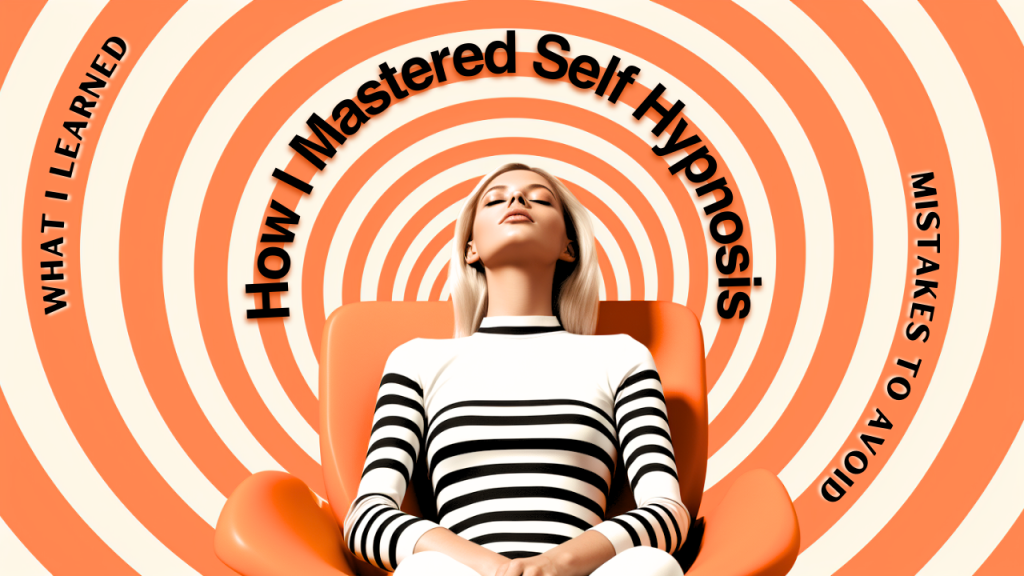Are you thinking about trying self-hypnosis to reduce stress, shed pounds, make more money, or achieve another goal? Self-hypnosis can be a powerful tool to help you achieve your goals. But if you’re new to it, there are self-hypnosis mistakes you should avoid.
Hypnosis is a great way to change your life for the better. It’s a natural state of mind that allows you to focus and connect with your subconscious. With self-hypnosis, you can finally make the changes you’ve always wanted. I know because it worked for me.

I’ll share the seven self-hypnosis mistakes that slowed my progress. Once I learned what to avoid doing, my self-hypnosis sessions were pure magic!
Avoid Common Self-Hypnosis Mistakes
If you try self-hypnosis without guidance, you will make mistakes that can keep you from reaching your goals.
You might think self-hypnosis induces a lack of control or awareness, but the opposite is true. Hypnosis involves a high degree of concentration and control.

It’s similar to a meditative state but with an entirely different purpose. Meditation is about emptying your mind, while self-hypnosis is about putting new thoughts and ideas into your mind with intention.
Self-Hypnosis Can Change Your Beliefs
By learning to master self-hypnosis, you can change what your mind focuses on and transform your life.
William James, the renowned 19th-century psychologist, discovered that if you change your habits, your life opens up new possibilities. I can vouch for this working in my life!
“If you can change your mind, you can change your life.”
William James
But to enter the hypnotic state, the conditions around you must be just right, or the mind will not be receptive to hypnosis.

Self-Hypnosis Tips For Success
My key techniques will show you how to avoid the seven self-hypnosis mistakes that block progress so you can achieve the relaxation and results you want.
Knowing what common mistakes to avoid lets you focus on what works best and get results faster.
7 Self-Hypnosis Mistakes To Avoid
1. Expecting instant results
Self-hypnosis requires time to develop. It’s an acquired skill. Be patient and consistent with your practice – results take time. Not years, but it might take a month or two to see results.

If you’re expecting instant results, you’ll only be disappointed. Instead, set proper expectations. And give yourself time to get better.
If you were lifting weights, you would not expect to see any significant results after a day or a week. But after a month or two of dedication, you’ll see results.
2. Avoid uncomfortable positions
Make sure you’re in a quiet space before beginning. Avoid positions you can’t maintain for 10 minutes but are not so cozy that you fall asleep. Use your favorite relaxation techniques.

Sit with your feet flat on the floor where you can maintain alertness. Don’t wear restrictive clothing, shoes, or anything that might distract you from relaxing.
3. Avoid shallow breathing
Focus on your breath. You must inhale through your nose for a count of four. Hold your breath for a count of seven. Exhale completely through your mouth, making a whoosh sound for a count of eight.
Repeat the cycle three times at the beginning of the session.

Deep breathing is an essential part of the hypnosis induction process. It’s natural to relax when we exhale; that’s what our bodies do.
Breathing deeply and slowing down the frequency of your breath helps calm your system and bring about a shift in your awareness.
4. Don’t try to hypnotize yourself if you’re stressed

The most crucial step is to relax your body completely. Feel your breath as you inhale & exhale. Tell yourself that you’re becoming more & more relaxed with every breath.
To achieve a hypnotic trance, your unconscious mind must disengage from daily life for some time during your hypnosis session.
5. Don’t be unprepared
Have your intention-filled suggestions written down. Your suggestions should be simple and present tense.

“I am calm and relaxed” is better than “I’m not afraid or stressed.” It’s best to keep the number of suggestions to 3 or fewer and repeat them silently to yourself.
6. Not using the power of your visualization
If you can imagine it and visualize it, you can create it. A powerful hypnosis technique uses your subconscious mind power while in a deep trance to picture your goals.

Visualize the goal you want; see it. Feel it, believe it.
When you visualize it, you can materialize it.
7. Be sure to end the session correctly
When the hypnotic session finishes, tell yourself it’s time to wake up and that you’ll be fully awake by the count of three. Then count 1-2-3 and wake up.

Tell yourself that you are fully awake, refreshed, and good.
Practice Self-Hypnosis Daily
Now that you understand the mistakes of self-hypnosis, it’s time to put these tips into practice to reap the benefits of hypnosis.

With a positive mindset, you should be well on your way to successful self-hypnosis sessions that can help improve different areas of your life.
Remember, the more you practice, the better your results will be. You may find that self-hypnosis is the key to unlocking your full potential just like I did.
An excellent tool for developing your intuitive skills is the Tarot. Learn how to do a Tarot reading to enhance your self-hypnosis practice.


